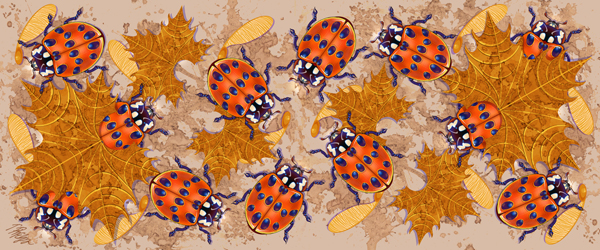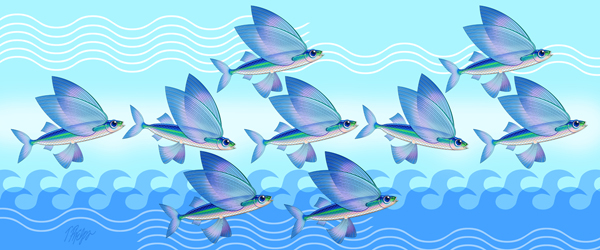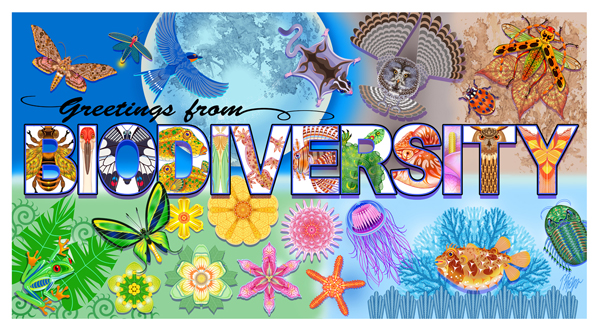- This topic has 0 replies, 1 voice, and was last updated 2 years, 9 months ago by .
-
Topic
-

Tim Phelps When did you first become interested in art?
As a child——art and nature have been ever present—my father was an amateur artist (but a great one) and I had a wonderful high school art teacher who pushed me into finding my own nature path.
University of Michigan, Ann Arbor, Michigan, M.S. in Medical/Biological Illust., 1979-1981.
Earlham College, Richmond, Indiana, Postgraduate Study in Biological Sciences, 1976-1977
Wittenberg University, Springfield, Ohio, Postgraduate Study in Biological Sciences, 1975-1976
Wittenberg University, Springfield, Ohio, BFA, 1971-1975.Honor Student-School of Visual Arts, New York, New York, Fall 1974
What style of art do you use most?
Pen and ink or solid shape outlines as a starting point for my art assets, then a variety of self-made marks and patterns for the creation of my animals and plants in combination with flat colors and some “airbrush” tone digital painting

Red Panther Chameleon Mandala ©Tim Phelps Has your style changed from when you first began as an artist?
Yes it has—I primarily create pen and ink line drawings and digital painted illustrations in a realistic manner for my medical and scientific illustrations clients in publishing—textbooks and scientific journals. (For the past 40 years). My current approach while utilizing the same research activities for scientific facts is much more creative and conducive to my “Nature FUN” art.
What medium do you use? Pen and ink and digital painting in an enhanced/personal graphic style.
What made you choose that medium?
I was looking for a different direction to highlight my playful style and my love for decorative pattern and ornamentation while still communicating aspects of the natural world. It is a departure from the exactness of my professional. But it has some exactness in the decorative patterns and treatments I create.
Do your ideas come from life or imagination?
They start with understanding the morphology and key identifiers of my intended plants and animals—then I go off on a romp and play with patterns and let the art take me along….one thing leads to another! I am always trying to capture the essence of my subject but in what I hope is a novel, authentic, and playful way while incorporating aspects of morphology, habitat, food source, and associations with other organisms.

Ladybug Leaf Litter Hideaway ©Tim Phelps How long does it normally take you to complete a piece?
Assets may take as long as 8 hours—with introductory science/biology research (minor time) and then actual art asset creation. After that it is finding the right number of images to place in my mandalas and panels that “feels right” in the symmetry—and again it is all about what I think looks good and is pleasing. And then adding my intended supplementary story with associated plants, leaves and decorative color patterns either based on pop culture of world indigenous culture that support my main topic.
Do you enjoy the creation of the piece (sketching out) or the finishing more?
It is both for—I love the asset creation and the process of navigating along a path that I do not always know where it will lead or end—I am always open to serendipity and try to suspend my self critic. The finishing placement part in the confines of a circle or rectangle arrangement certainly is satisfying.
Do you work in a studio?
Home studio is just part of a bedroom—by the time I sit at the computer my inspiration has preceded…..but there is a collection of odds and ends…photos, animals stuff etc in clear view.
Up in Flames: The Art of Flame Painting (MBI 2006) Biographies of 18 hot rod flame painters, Author
Nature Mandalas: Wonders of the Garden: Life Circles of Biodiversity and Conservancy
Volume 1, Schiffer Publishing, Atglen PA, Jan. 2016, 80 color illustrations, Sole Illustrator and Author.
Nature Mandalas: Wonders of the Earth Air and Sea: Life Circles of Biodiversity and Conservancy Volume 2, Schiffer Publishing, Atglen PA, Jan. 2016, 70 color illustrations, Sole Illustrator and Author.Which other artist, dead or alive, would you love to meet?
I have had the opportunity to be taught and mentored by some of the best medical and scientific illustrators i
n my career —many now deceased——I would like to have spent even more time with them: Gerald Hodge, Jack (John) Cody, Craig Gosling. A few I never knew might include: Max Broedel, Will Shepard, Mary Dixon, and Elizabeth Buchsbaum.
What is your favourite piece of work by yourself? For many reasons the flyingfish wave panel is my favorite

Flying Fish Wave Panel ©Tim Phelps It came at a time I was exploring beyond the mandala circle and into an out of the box approach with rotatable panels. And, fish have always been on my nature radar since I was a child.
I grew up in a household of “a-fishionados.” My late father enjoyed freshwater and saltwater fishing and instilled the love of fishes in his 3 amigos. My two older brothers as teenagers had multiple freshwater tropical fish tanks with varieties of cool and colorful fish including oscars, angelfish, and catfishes (my favorite), and separate aquariums for Siamese fighting fish and a piranha. Later in his life my father continued his fascination with aquariums breeding Ancistris Plecostomus suckermouth catfish. In graduate school at the University of Michigan my master’s paper was titled “Six species of Lorcaria from Paraguay.” Loracariidea is the family of armor-plated catfish that includes many varieties of Plecostomus a few of which found their way a few years later into a 55 gallon tank that amused my young children years ago. And the flyingfish image was picked as a billboard winner—and having seen it here @ 14” x 48” in my town of Baltimore—it is special to me.
How well do you take criticism?
I take it well and seek it——as an art instructor I try to frame what I can speak to that my students have done well and what they might try to make their image better (art wise and in communicating a scientific or anatomic message) —with that in mind I am always searching for the same constructive criticism and probe into the success of my art—but also in both cases it is understanding who their/my audiences are and what are their expectations……different from my profession in that my clients have specific goals and needs to describe their concept which I am charged to bring to life visually in my images———I must please them before myself—(not that I don’t find my professional work pleasing and creative)—but in my art creation—I get to please myself and hope that others find my work appealing and creative!

Greetings from Biodiversity ©Tim Phelps What do you do to overcome a ‘block’?
I think it is stepping away and perhaps even taking break from all things art related—those can provide ah-ha moments when you least expect it.
Years of training, direct observation, and inspiration have taken me down my chosen path. I am going to stay with that path. I embrace the creative and intellectual challenges that come with it all. This leads me to many artistic beliefs, reminders, and directives for artistic peace of mind:
Embrace comfort in the process of the creative act
Apply meaning to the images you create
Ponder what is just around the corner
Stay true and authentic
Reach down into your well of experience and inspiration
Dispense with your inner critic
Do not compare yourself to others
Stay true to the things that make you happy and fulfilled
Be inspired by others without thinking you must be just like them
Look for common ground in uncommon connections
Strive for authenticity
Embrace anticipation in your search of artistic expression
Explore your past for inspiration
Cast off permissions based on perception
Make art “play” and not “work”
Separate process and destination
Learn from mistakes
Seek and savor serendipity
Balance the Teeter-totter of work life and art life
Credit your mentors
Borrow knowledge and pass it to others
Be both a teacher and student in all that you createInstructor and artist, Tim Phelps, invites you to take an exciting eco-trip “around” his world of nature mandalas. His 10-year project has resulted in over 700 nature images celebrating biodiversity and conservancy with a bit of fun (Tim created special mandalas for NHSM to celebrate Brood X Cicadas and Shark Fest). The circular mandala form is the perfect representation and embodiment of structural balance, coincidentally, also found in all plants and animals. Mandalas are engaging, thought provoking, meditative, and joyful tools. Join Tim Phelps a professor and medical illustrator @ Johns Hopkins for
a workshop of mandala exploration and mandala making. Open to ages 7-99. Learn more about Tim’s mandala work here: https://phelpsmandala.com/Timothy Phelps is a professor at the Johns Hopkins University School of Medicine. Professor Phelps serves as the assistant director of the Department of Art as Applied to Medicine. His area of expertise is medical illustration.
He has received more than 40 regional and national awards for his artwork published in textbooks, magazines and professional journals. He has been illustrating medicine and science for 30 years, and his work has appeared in more than 60 surgical textbooks and atlases, 300 book chapters and journals, and 20 magazines.
How do you know something is ‘finished’? Is it easy to walk away?
I get a general feeling that this image before me satisfies and often exceeds what I was expecting and hoping for….and Yes after —the art sits for awhile I may go back add minor additional details.
Have you had exhibits in galleries?
Not really—professional salons for my association (Association of Medical Illustrators) and a few solo and group shows. Namely;
Participation in 50+ group and solo exhibitions for medical and scientific illustration.
Society of Illustrators exhibit- “Illustrators Who Teach,” New York, 1998.
Artwork displayed in 100+ textbooks, 300+ book chapters and 30+ professional journals, 20+ Patient Ed Guides
Primary illustrator and Art Director for The Johns Hopkins Family Health Book, 500+ illustrations, Harper-Collins, New York, 1999.
Have you any exhibits in galleries planned for the future?
I do not but I am investigating some future associations with Baltimore Zoo, Natural History Society of Maryland and The National Aquarium, for volunteering and possible exhibit venues.

Green and Yellow Birdwing Mandala ©Tim Phelps What are you currently working on?
Continuing looking for new animal and plant species to explore, more decorative ornamentation pattern opportunities and exploring more rotatable panels that can be displayed either horizontal or vertical.
What are your plans for the future?
Semi – retirement after 37 years of teaching and 42 years in my chosen profession ….and more explorations of nature.
Do you think the internet has altered the way artists can get known?
This is such a huge moving target in not only copyright infringement but in actual art creation and appreciation by the public……And with so many artists and “artists” everywhere—marketing and getting the eye of the public is difficult—nearly impossible.

Flying Great Grey Owl Mandala ©Tim Phelps Have you done any courses to help you?
not at this time—constant learning in medicine and science every day on the job
Do you use social networking in your day to day life?
Post many twice a week
Facebook: Nature Mandalas of Tim Phelps
Instagram phelpsmandalaAre you available for work (commissions)?
I am
 Instructor and artist, Tim Phelps, invites you to take an exciting eco-trip “around” his world of nature mandalas. His 10-year project has resulted in over 700 nature images celebrating biodiversity and conservancy with a bit of fun (Tim created special mandalas for NHSM to celebrate Brood X Cicadas and Shark Fest).
Instructor and artist, Tim Phelps, invites you to take an exciting eco-trip “around” his world of nature mandalas. His 10-year project has resulted in over 700 nature images celebrating biodiversity and conservancy with a bit of fun (Tim created special mandalas for NHSM to celebrate Brood X Cicadas and Shark Fest).The circular mandala form is the perfect representation and embodiment of structural balance, coincidentally, also found in all plants and animals. Mandalas are engaging, thought provoking, meditative, and joyful tools. Join Tim Phelps a professor and medical illustrator @ Johns Hopkins for
a workshop of mandala exploration and mandala making. Open to ages 7-99.Timothy Phelps is a professor at the Johns Hopkins University School of Medicine. Professor Phelps serves as the assistant director of the Department of Art as Applied to Medicine. His area of expertise is medical illustration.
He has received more than 40 regional and national awards for his artwork published in textbooks, magazines and professional journals. He has been illustrating medicine and science for 30 years, and his work has appeared in more than 60 surgical textbooks and atlases, 300 book chapters and journals, and 20 magazines.
Have you got hobbies?
I have been flame painting miniature die cast cars (1/64 scale (about 3 inches long)—Hotwheels and Matchbox since 1994—over 600 to date——which led to the authorship of a book about 18 famous hot rod flame painters in 2006—“Up in Flames” The Art of Flame Painting” (MBI 2006).
I also am at peace from Spring to fall working in my yard of lilies, hosta, and Rose of Sharon—all of which are subjects of many previous mandalas.
Do you have a significant other? Are they supportive?
I do—I think she is just neutral on my artistic pursuits…LOL (as long as I don’t paint flames on the refrigerator…..)

Barn Owl Midnight Mandala ©Tim Phelps What do your family think about what you do
Children and other family members are very interested.
What do you dream about when asleep?
I often get an idea in my head and have to turn on the light and write it down so that it is not lost in the morning…
Where are you based?Baltimore MD
I invite you to visit to my blog @ phelpsmandala.com that will provide many more thoughts and ruminations, as well as more of my background and art influences.
Post Permalink – https://ourartsmagazine.com/blog/getting-to-know-tim-phelps/
⋱⋰⋱⋰⋱⋰⋱⋰⋱⋰⋱⋰⋱⋰⋱⋰
Site Owner • Community Manager
Artist • Authoress • Big Beautiful Woman
Lover of Wolves, Woods, and Wild Places
⋱⋰⋱⋰⋱⋰⋱⋰⋱⋰⋱⋰⋱⋰⋱⋰
- You must be logged in to reply to this topic.